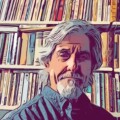News & Articles
Browse all content by date.
He first caught my attention at the Clyde-O-Thon, a two-day tattoo show a couple years back. He had a table there with some of his work, but was also making paintings of the scenes about him. The small canvases reflected the rich, vivid energy there, which seems to be his style, to reflect his surroundings, to illuminate the now. His work is currently on display at the Duluth Art Institute till August 18 in the Corridor Gallery.


EN: What is it you like about painting in oils?
Lee Englund: I have loved oils almost all my life. I love the creamy way that oils mix. The buttery feel that it has and the “real look” that it has. It is not plastic looking. I love that painting in oils is a life-long learning experience. Working in oils is exciting. It stays wet on the canvas for a long time, and I love working wet into wet. You can also move paint around on the canvas.
EN: What does it mean to paint “en plein air”?
LE: Painting “en-plein-air” is like jazz improvisation. You “interpret the score” as literally or creatively as you feel. It is feeling the scene in front of you with all your senses. It is “true painting.” Plein air painting is in the moment and the moment changes fast. It is a humbling experience. The light changes, the weather changes. There is wind and sometimes bugs. It is a real challenge and a true learning experience.
EN: You’ve won some national competitions. How do those events work and what are the rules?
LE: There are many national painting competitions. The Juried national competitions are usually medium specific, but some have categories of mediums within the competition. I also enter a few plein air competitions where painters travel to the event, get their canvasses stamped (to prove that you painted your work right there on the spot) and work for a specific few days. There is also a Quick Paint competition within the plein-air event. The artists set up in a specific area. A starting gun is shot, and painting begins. The artist has an hour and a half to complete his or her painting. There is always a show of wet paintings at the end of the event. I was recently accepted to the Hilton Head National Juried Competition.
EN: What do you consider your most significant achievement?
LE: Getting in to National competitions and winning several awards has been rewarding, but I think seeing my work and my passion for it grow over the years is the biggest reward. I feel lucky to have the passion that I have.
EN: What’s the appeal of painting “en plein air”? Is it becoming more popular again and why?
LE: Plein air painting has become popular in the past few years because artists are finding plein air painting to be such a good learning experience. Art students at the Moscow Institute are required to paint en plein air for a year to learn color. If you love nature you get to spend a lot of quality time with it when you plein air paint.
EN: You were an art teacher at Denfeld and are now retired. How does that feel and how are you spending your time?
LE: I retired in 2007, and went back to school for my masters in fine art. I then taught at Lake Superior College for two and one half years. I just retired again in May. I am excited now to be able to paint full time and I’m grateful to be so lucky to have a passion for painting. I travel and paint from life, and that is the plan for my life. Next year my wife and I will travel to Austria and Italy to paint for about a month.
EN: What are some things you have learned through teaching art to others?
LE: I have learned so much over the years from my students. I have seen so much talent blossom and grow that I could not help but learn. I like to experiment every time that I paint. One of my students said “There is so much to think about when you are painting.” So true! One thing that I know for sure is that it takes a lot of work to become a good painter. Something I will always strive for, for the rest of my life.
| Tweet |


